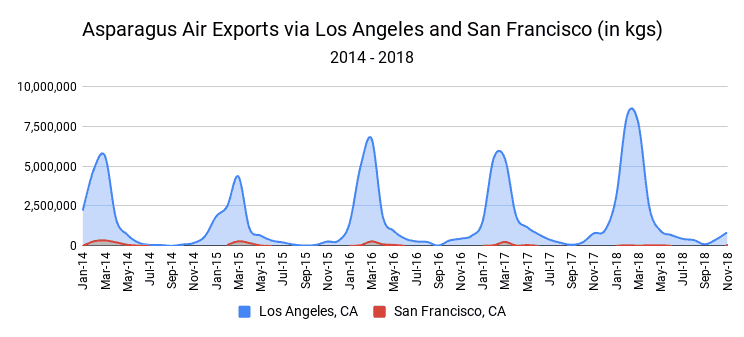February and March are peak months for California and Mexico asparagus air exports. Ground zero for these movements is Los Angeles International Airport (LAX). Along with cherries and strawberries, asparagus is one of the top three perishable products based on tonnage exported each year by air from California.
Starting first in late January with shipments of Mexican-grown asparagus and moving up the coast to shipments from various asparagus-growing regions in California, it’s an intense and short peak season, and then it’s over. Across a full year, asparagus may represent 4.5 to 6 percent of the overall tonnage shipped by air from LAX, but during this short February-March time frame this single commodity – peaking at over 8 million kilos in a month – can represent up to 23 percent of the gross tonnage of all commodities exported from LAX! This level of concentration is remarkable considering that LAX is such a large and diverse international air cargo gateway.
From an air cargo perspective, asparagus is typically welcomed by the local LAX airline community as the year’s first healthy injection of export volume. The product is dense, well-suited to the lower deck cargo holds, and “builds” (stacks) consistently to maximum weights of 4,500 kgs and more on 96 x 125-inch airline pallets. For passenger flights, moving multiple heavy pallets on a single flight takes some good aircraft weight and balance planning, considering varying passenger loads and other local dry cargo which is typically much lighter, at 1,000-1,400 kgs per pallet. Even on air cargo freighters on which the product could be built higher, it is typically only stacked to 62 inches lower deck height, due to the high weights of the pallets and the concern that added weight could crush lower layers of product.
Asparagus flies on the various international passenger or freighter flights directly from LAX to Asia, Europe or the South Pacific. In addition, major U.S. passenger airlines such as American, Delta and United with domestic widebody flights from LAX to Midwest or East Coast U.S. gateways also have the ability to route asparagus destined for Europe into these hub cities. But then short layover times, keeping the product protected and making planned connections into Europe are all critical to keep the product fresh. You may have fresh asparagus under your feet if you are flying from any of these hubs to Europe!
The sharp seasonal peaking in the February-March time frame over the last five years can be seen below. Asparagus is also a great example of the cross-border nature of food supply chains. In fact, Mexico is the top global exporter of fresh asparagus by value worldwide, with $460 million in 2017, followed by Peru. But Spain’s export value is coming up quickly too. While the U.S. exported over $80 million of fresh asparagus in 2018, overall it is a net importer of the product, with U.S. Department of Agriculture data trending over $600 million in imports for 2018, primarily from Mexico and Peru.
Mexico’s main growing area is located in Caborca, in the state of Sonora, which is south of Arizona. Getting fresh product to market means moving it quickly by refrigerated trucks to the largest air gateway in the region, i.e. across the U.S. border to LAX. It’s a sensitive, perishable product that requires quick cooling after harvest and delicate cool chain handling to avoid toughening, decay and loss of flavor. Grown in Mexico from December through April, the overall trend line on the chart is a combination with California-grown product that is grown from January through mid-June. Airports in San Francisco (SFO) and San Diego (SAN) also fly out small portions of the tonnage during the season’s peak.
California remains the largest U.S. producing and exporting state for asparagus by far. In California, there are three major growing areas, including the Sacramento-San Joaquin River Delta, the Central Coast and the San Joaquin Valley, with smaller areas from the Sacramento Valley in the north to the Imperial Valley in the south. At the same time, there is increased competition from Spain and other growing areas and that is causing some farmers to shift away from asparagus to other more profitable products. Lesser quantities of the product are grown in other states including Florida, Hawaii, Michigan, Texas and Washington, but export volumes from these states are modest and inconsistent.
Fresh asparagus is shipped to most countries in Europe, Asia and the South Pacific, but the top international markets for fresh asparagus shipped from California include Japan, Australia, Netherlands, Spain, United Kingdom and Switzerland. Korea, Singapore and Hong Kong have also increased their consumption rapidly in recent years. Nearly all of the product shipped from the U.S. and Mexico is the green asparagus familiar to most Americans, but there is also white asparagus, which is considered a delicacy in many parts of Europe and is grown there. This product is grown in a way that keeps any sunlight from reaching the spears, so that no photosynthesis occurs.

The strength of each export season can vary with weather and harvest conditions, as well as the quality of asparagus harvests and market conditions in Peru, Spain and other parts of the globe. This year, for example, the Mexican harvest started later than normal in January due to cooler weather, and is running about 10 days behind normal. Demand from the domestic U.S. market is also strong this year and competing against international buyers.
For the trucking industry, asparagus is a short time-frame, high-volume opportunity that requires refrigerated trucks and tight cool-chain management to avoid spoilage. Typically trucking from farms or border cross-dock locations into LAX is arranged by the growers, while international logistics are coordinated and concentrated by a small group of perishables-forwarding companies including Able Freight Services, Commodity Forwarders and HPL-Apollo.










